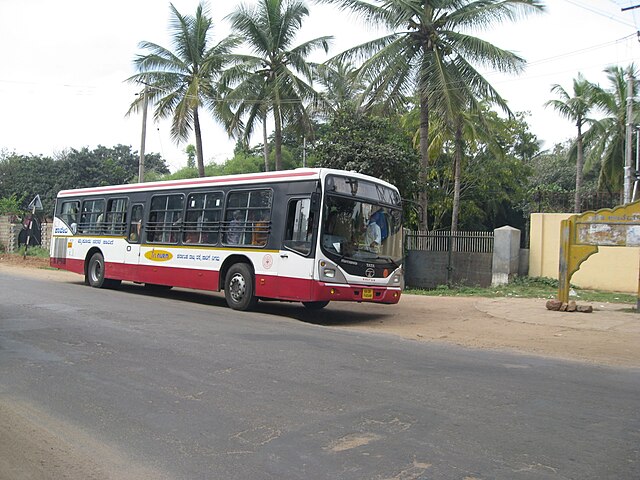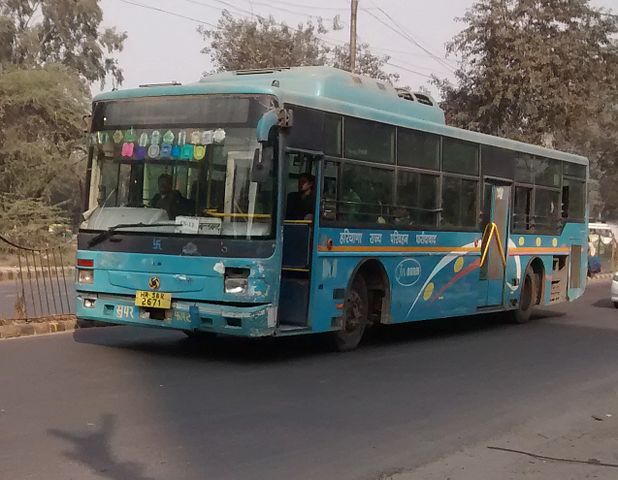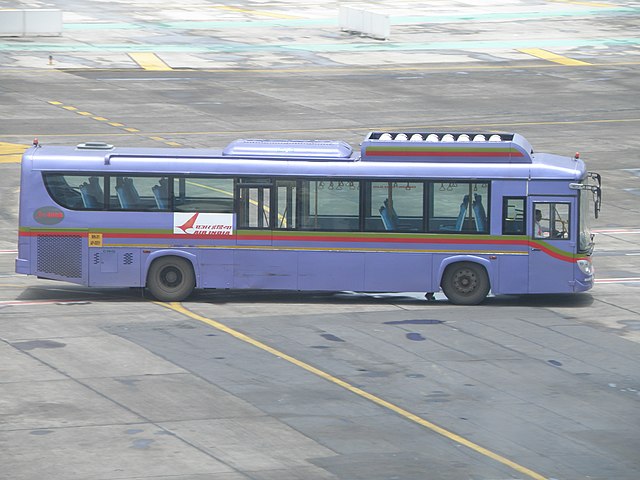The Jawaharlal Nehru National Urban Renewal Mission [JnNURM] is probably one of the most well known Government schemes that happened from 2005 to 2014. Anyone living in a big city would know what JnNURM is purely because of the ugly JnNURM logo being plastered everywhere, from buses to flyovers and ultimately to ultrasonic flow-meters used to measure water flow in underground supply systems.
![Logo of the Jawaharlal Nehru National Urban Renewal Mission [JnNURM].](https://upload.wikimedia.org/wikipedia/commons/1/1c/JnNURM_logo.jpg)
Among the various points mentioned in the above document; Point 3 talks about Definitions. It defines State as a State or Union Territory, a city as a City, Agglomeration, or Metropolitan area defined by the State, and Special Purpose Vehicle [SPV] as meant to run bus services within a city. It also states that existing corporations such as BEST, DTC, BMTC et al, also come under the definition of an SPV. A crucial thing to note here is Point 3.4 which talks about Para-Statals like KSRTC and APSRTC, which can operate buses under JnNURM, but would require an SPV at city level, OR could set up an SPV for a cluster of cities under Point 3.5.
Now, not all transcos followed the JnNURM guidelines. State level transcos as well as their city level counterparts did what was ideally not permitted.
Now let us list out all the violations that were possible; and then examine them case-by-case. This article only deals with the operating body, and jurisdictions. Another article will come soon on violations of bus specifications.
- Not setting up an SPV to handle JnNURM buses.
- Using JnNURM buses outside the city or area where they were to be used.
- Using JnNURM buses for purposes other than Public-Transport.
Now that the violations have been listed, let us examine, on a case by case basis, what each transco did.
Metropolitan Transport Corporation/Tamil Nadu State Transport Corporation

One of the earliest pioneers in the JnNURM violations, the MTC recieved a set of Volvo B7RLEs which it operated inside city limits, on routes such as CMBT-Red Hills or CMBT-Chengalpattu. It also ran on routes such as 588B from Broadway to Mamallapuram, which is acceptable as it is a city route. The issue cropped up when MTC transferred some of its Volvo buses to TNSTC Villupuram, and began using them on various intercity routes such as Chennai-Puducherry, Chennai-Hosur, and Chennai-Trichy. Perhaps its MTC which is innocent and TNSTC which is the culprit.
TNSTC Coimbatore and TNSTC Madurai received non-AC Semi-Low-floor [SLF] buses for intra-city use. These buses were not used on routes outside of their respective cities but there was no SPV created for them. Of course, one may argue that TNSTC Coimbatore’s JnNURM buses were used exclusively in Coimbatore and not in Erode or Ooty and thus TNSTC CBE is not the para-statal here but merely a city-specific transport corporation.
Puducherry Road Transport Corporation
On the lines of the TNSTC-MTC mischief-making duo, the PRTC got itself a set of SLFs under JnNURM. PRTC hardly used any of them in its capital city. Instead, it chose to ply them between Pondicherry and Karaikal. One may argue that there is nothing wrong in this as they are two parts of Pondi only. They then ran them on East Coast Road [ECR] along with the TNSTC VPM Volvos. This, made them serial offenders, just like the others.
Kerala State Road Transport Corporation

Another arty and masterful violator, KeSRTC received Volvo B7RLEs for use in Kochi and Thiruvananthapuram. What did they do with these? Run them on intercity routes, of course. No SPV was created. The Central Government stepped in and objected to this violation, going so far as taking KeSRTC to court.
However, being crafty, the KeSRTC found a work-around for this. The court order affected only buses belonging to the Kochi division, prompting KeSRTC to transfer most of these buses to the Thrivananthapuram division. The reason? These buses were super-profitable and KeSRTC otherwise had only one Volvo service between Trivandrum and Bangalore, which was running at a loss due to KaSRTCs super-efficiency.
In November 2014, KeSRTC finally created an SPV called the Kerala Urban Road Transport Corporation [KURTC] exclusively for JnNURM buses, thus making it an SPV for a cluster of cities.
Karnataka State Road Transport Corporation

Among the most ethical State Transport Undertakings in India, KaSRTC has actually followed most of the rules in the book. However, it did miss out on a few:
- Mysore received a batch of Volvo and non-AC buses under the JnNURM. These buses were operated by the Mysore City Transport Department [MCTD] of the KaSRTC. The MCTD had existed long before launch of JnNURM. In 2010, in order to comply with JnNURM norms, the state government decided to initiate the process of turning the MCTD into the Mysore City Transport Corporation [MCTC] as a body to not only operate buses [JnNURM and otherwise], but also for ease of implementing a World Bank-funded Intelligent Transport System [ITS] in the city. Of course, this was shelved when the government changed in 2013.
- Funding later on came for other cities including Hubli-Dharwad, Mangalore, Belgaum, Tumkur, etc, but no SPV was set up.
- Buses in the city of Hubli-Dharwad were operated by the North-West Karnataka Road Transport Corporation [NWKRTC]. In early 2014, the government set up a new entity, the North West Urban Transport Corporation [NWURTC], to operate JnNURM buses in the Hubli-Dharwad region.
- In 2012, the Government of Karnataka, NWKRTC, Hubli-Dharwad Municipal Corporation [HDMC], Hubli-Dharwad Urban Development Authority set up a company, the Hubli-Dharwad BRTS Company as an SPV that would oversee the construction, upgradation of the old Hubli-Dharwad Highway thru the twin cities, commissioning of the BRTS and its operations.
KaSRTC has lived up by trying to follow norms as much as possible. One just hopes that Mysore and Mangalore get their own transport corporations soon.
Andhra Pradesh State Road Transport Corporation/Telangana State Road Transport Corporation

The APSRTC, during the United Andhra days operated JnNURM buses in Hyderabad, and Visakhapatnam. It continues to operate the latter, while its younger sibling the TSRTC has taken over the erstwhile capital. There is no SPV to handle city operations. One hopes that the upcoming capital of Amaravati will have its own Transco, with funding under AMRUT.
Along with this, several of the Volvo “Metro Luxury” buses have found their way to intercity routes, both in AP and Telangana.
Note: Thanks to GSR Chaitanya for pointing out that APSRTC/TSRTC did indeed have an SPV. An article on this was posted a year earlier on Love of Z, a blog dedicated to APSRTC/TSRTC buses. You can read the article here.
Buses in Hyderabad, on paper operate under the aegis of the Hyderabad Zonal Urban Road Transport Corporation.
Haryana Roadways

Another serial offender, Haryana Roadways has both non-AC buses like the above, as well as Volvo B7RLEs, both of which, were allotted to the Faridabad division. Once again, there is no SPV here, and these buses always operate on the Gurgaon-Faridabad-Ballabgarh route. Buses that operate within Gurgaon, however, are non JnNURM buses.
Bangalore Metropolitan Transport Corporation

The BMTC, one of the largest beneficiaries under JnNURM, is a mere crook among the no-goodniks of the Transport world. It’s only violation of the JnNURM guidelines? Renting out buses. A large chunk of BMTCs revenue comes from leasing out its Volvo fleet to the IT sector for dedicated pickup and drop trips. The BMTC quickly rectified this however by purchasing brand new Volvo buses and deputing the JnNURM ones for Public Transport. A good move to conform to norms, but the downside? The IT sector gets the really good buses, the rest of us, nothing.
Brihanmumbai Electricity Supply and Transport

Another small-time crook in the world of the Mafioso, BESTs only mistake in violating JnNURM guidelines was leasing out its Second-Generation Cerita [yep, them Purple Faeries] to Air India to ferry passengers between the aircraft and the terminal. The cash-strapped body, with annual losses of ~₹700crore needed to monetise its fleet, and did so by leasing them out. However, word has it that the after the Air India agreement ended, BEST has been leasing out its older, First-Generation, Single-Door Cerita buses which were not acquired under JnNURM. In order to further monetise them, BEST put out full body adverts on them, thus turning them into giant, moving billboards.
Now that we’re done with the villainous lot, let’s head to the heroes of the hour!
Jaipur City Transport Services Limited
This SPV was set up by the Rajasthan State Road Transport Corporation in 2008 to handle city buses in Jaipur. It operates JnNURM buses, other buses as well as the Jaipur BRTS.
Atal Indore City Transport Services Ltd

Set up to run bus services in Madhya Pradesh’s largest city, Indore, the AiCTSL, operates city buses, as well as the BRTS. It also operates a Radio Cab service in the city.
For a further reading on JnNURM funding of buses, please read this.
JnNURM has been scrapped in favour of the Atal Mission for Rejuvenation and Urban Transformation [AMRUT]. While nothing concrete has been set for buses, one hopes that AMRUT paves the way for more intelligent transit in the country.
Which Transport body has violated JnNURM guidelines in the country? Share on X
![]()
